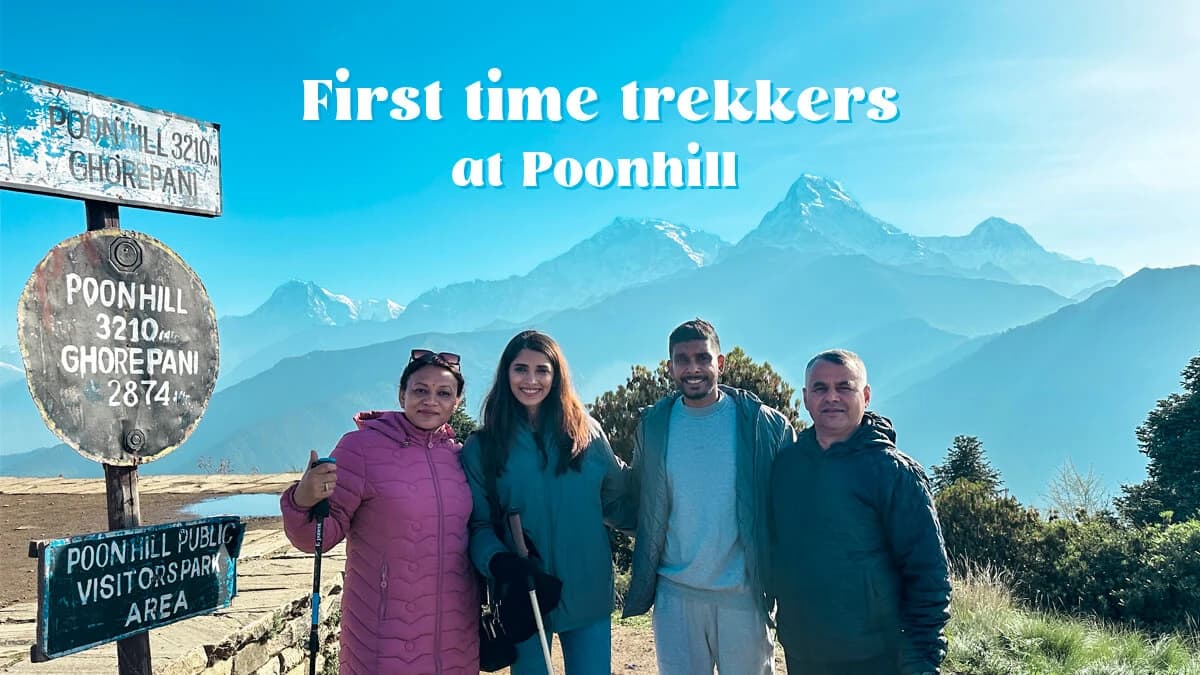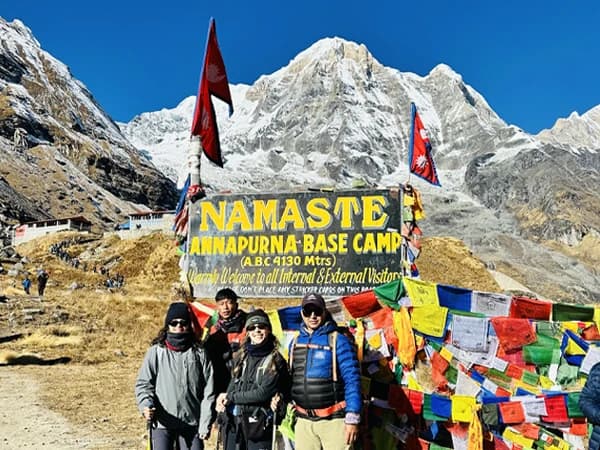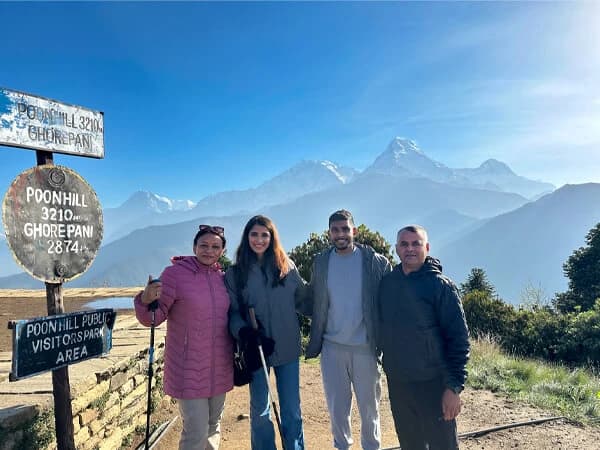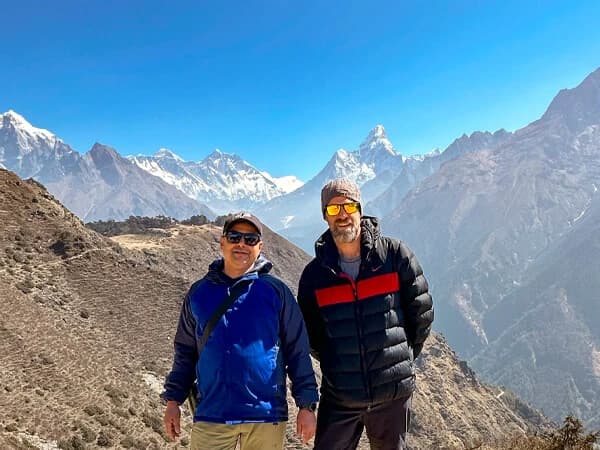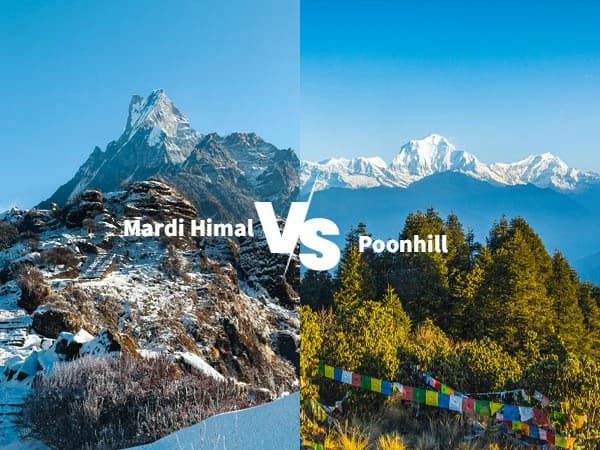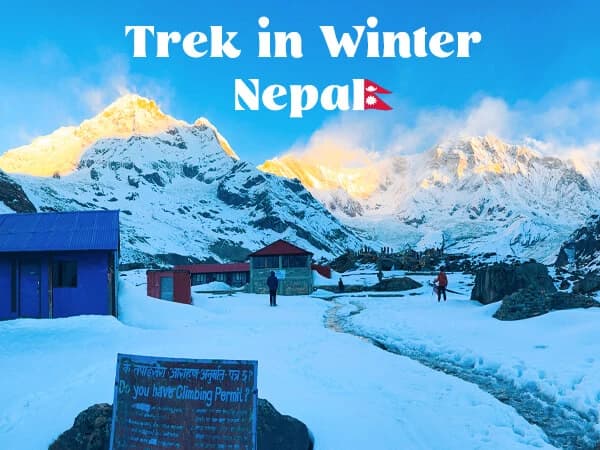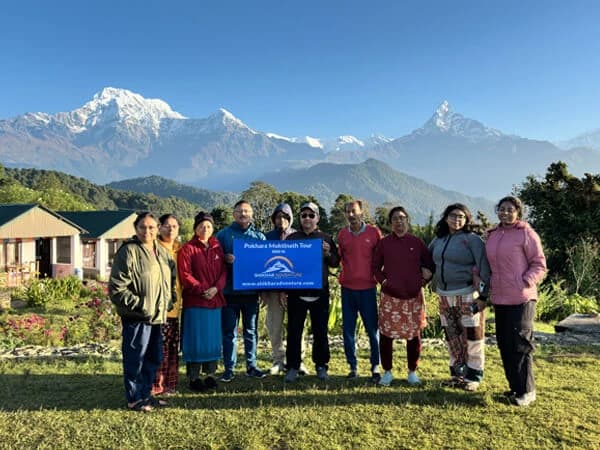Wondering if Nepal trekking is possible for beginners without experience? This complete guide reveals the 5 easiest Himalayan trails, honest fitness requirements, real 2026 costs, and an 8-week training plan that transforms anxious first-timers into confident trekkers. Everything you need to start your mountain adventure today
Nepal Trekking for Beginners: Everything You Need to Know (2026)
Nepal Trekking for Beginners: The Only Guide You Need
Abarna Ravi had never hiked more than five miles. Nevertheless, she stood at Poon Hill's summit watching the sunrise paint Annapurna gold. Her first Nepal trek was complete. Furthermore, she'd conquered every fear that almost stopped her from booking.
If you're wondering whether you're fit enough for Nepal, you're not alone. Moreover, questioning your experience level shows wisdom, not weakness. In fact, the best trekkers are the ones who prepare thoughtfully.
Over 15 years, I've guided more than 200 first-time trekkers through Nepal's mountains. Additionally, I've watched people of all ages discover their hidden strength.
Therefore, I can tell you this with certainty: successful treks aren't about being athletes. Instead, they're about smart preparation and choosing the right trail.
Why This Guide Is Different
Most beginners feel overwhelmed when planning their Nepal adventure. Consequently, they spend weeks drowning in conflicting advice. Furthermore, generic blogs rarely answer the questions keeping you awake.
"What if I get altitude sickness halfway up?" you wonder. Similarly, you might ask, "Will I be too slow?" Additionally, there's the bathroom situation—nobody talks about it.
As a result, many abandon their Himalayan dreams before trying. However, this guide eliminates that uncertainty completely. Specifically, you'll get honest assessments, real costs, and a proven 8-week timeline.
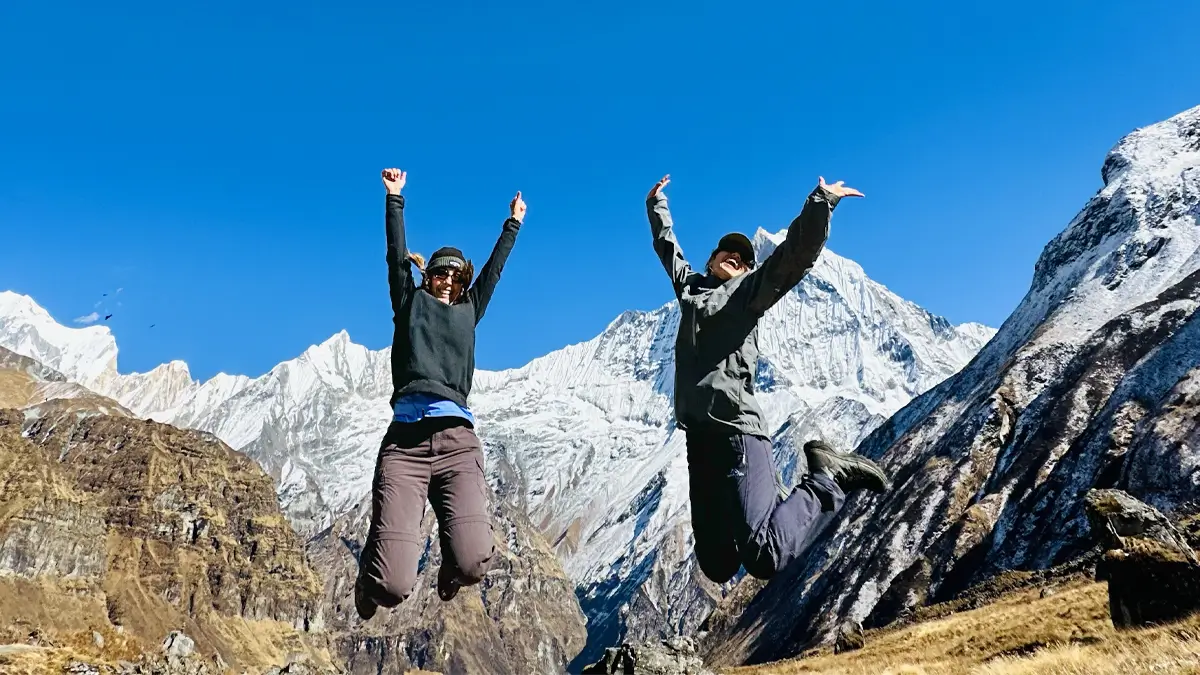
What to Expect on Your First Nepal Trek
Beginner-Friendly: What It Means
Beginner-friendly doesn't mean easy—it means achievable with preparation. In contrast to Instagram posts, Nepal trekking involves real effort. However, it's more accessible than most imagine.
Let's address altitude first, since it's your biggest concern. Consequently, understanding elevation helps manage expectations. At 3,000 meters, the air feels noticeably thinner. Nevertheless, your body adapts well with gradual ascent.
Your Typical Trekking Day
Here's what typical days look like on beginner treks. First, you'll wake around 6:30 AM as sunlight hits your window. Next, you'll enjoy breakfast—eggs, toast, and Nepali tea. Subsequently, trekking starts around 7:30 or 8:00 AM.
Most days involve 4 to 6 hours of walking. However, this isn't continuous hiking like you imagine. Instead, there are many teahouse breaks along the way. Also, guides keep a purposely slow pace called "pole pole."
How to Understand Differences in Trails
The trail conditions are very different between beginning treks. Poon Hill, for example, has stone steps that lead through rhododendron woods. On the other hand, the slopes in Langtang Valley are less steep along the river bottoms. Because of this, picking the right trip is very important.
Reality of Teahouse Accommodation
Teahouse lodges provide accommodation throughout your journey. However, forget any glamping fantasies you harbor. Instead, expect simple twin rooms with thin mattresses. Nevertheless, they're clean, warm with good sleeping bags, and remarkably social.
Hot showers cost extra—usually $3 to $5 each. Similarly, device charging runs $2 to $4 per charge. Additionally, WiFi exists but remains slow and unreliable.
The Fitness Baseline Test
"I've never done multi-day hiking," you're thinking. Consequently, you wonder about baseline fitness requirements. Here's the honest test: can you climb three flights without stopping? Additionally, can you walk two hours comfortably?
If yes to both, you have the foundation. Furthermore, our 8-week training plan builds systematically. As a result, you'll arrive genuinely prepared.
5 Perfect First Treks in Nepal (Easiest to Moderate)
Poon Hill Trek: The Confidence Builder
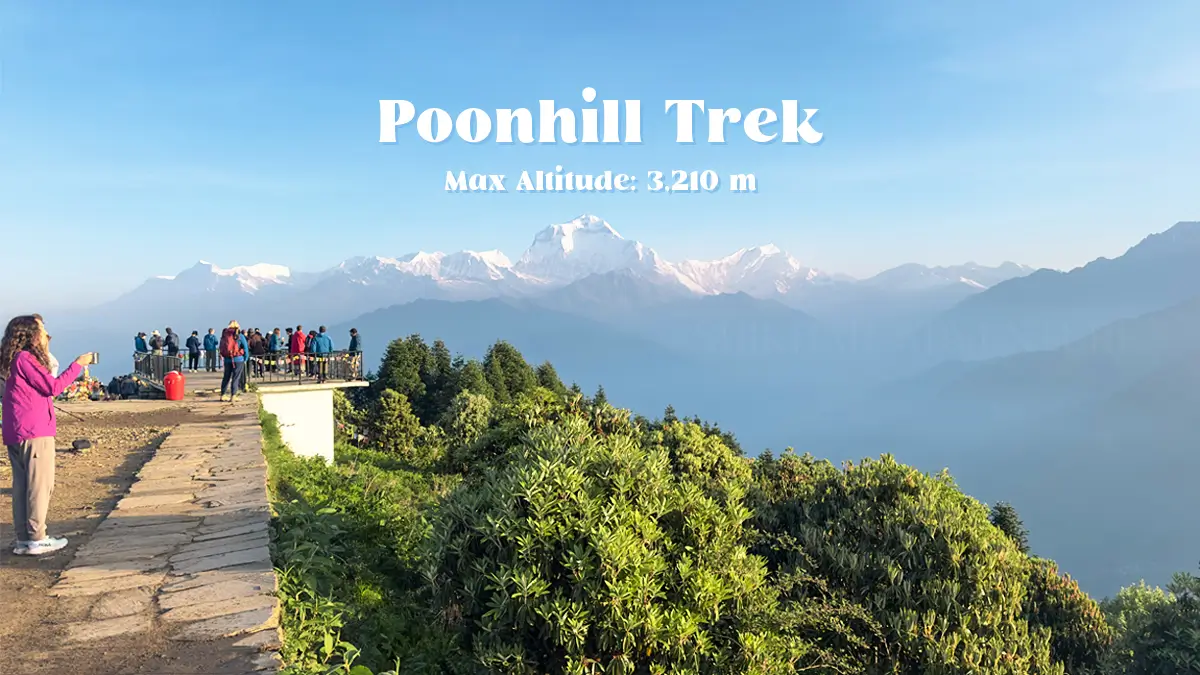
Quick Facts:
- Duration: 4-5 Days
- Maximum Altitude: 3,210m (10,531ft)
- Difficulty: Easy
- Daily Walking: 4-6 hours
- Best Months: October -November & Early March - April
Why It's Great for Beginners:
The trek is the best way to get to know Nepal. In particular, the short length lowers the stress of commitment. The relatively low elevation also lowers the risk of getting mountain sickness. Also, the framework of a good teahouse makes the whole experience comfortable.
What to Actually Expect:
Day one involves a scenic drive to Nayapul. Subsequently, you'll trek to Tikhedhunga through terraced farmland. Meanwhile, the trail gradually introduces you to trekking rhythms.
Day two brings the famous Ulleri stairs—3,200 stone steps. However, frequent tea stops make it manageable. Furthermore, reaching Ghorepani feels like genuine achievement.
The sunrise at Poon Hill is genuinely spectacular. Consequently, waking at 4:30 AM feels worthwhile. In fact, watching Dhaulagiri and Annapurna glow creates unforgettable memories.
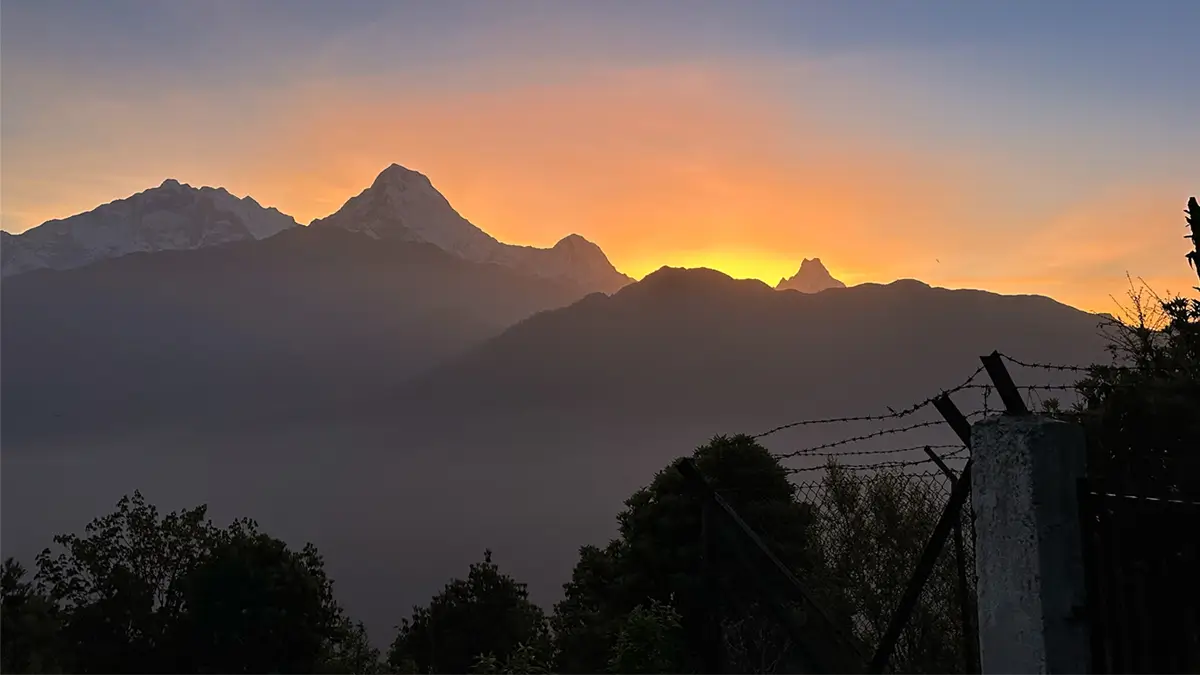
Who Should Choose This:
Perfect for testing whether you enjoy Himalayan trekking. Similarly, ideal for limited vacation time. Additionally, excellent for those nervous about altitude.
Avoid If: You want complete solitude—peak season brings crowds.
See our complete Poon Hill Trek itinerary and 2026 dates →
Langtang Valley Trek: Cultural Immersion
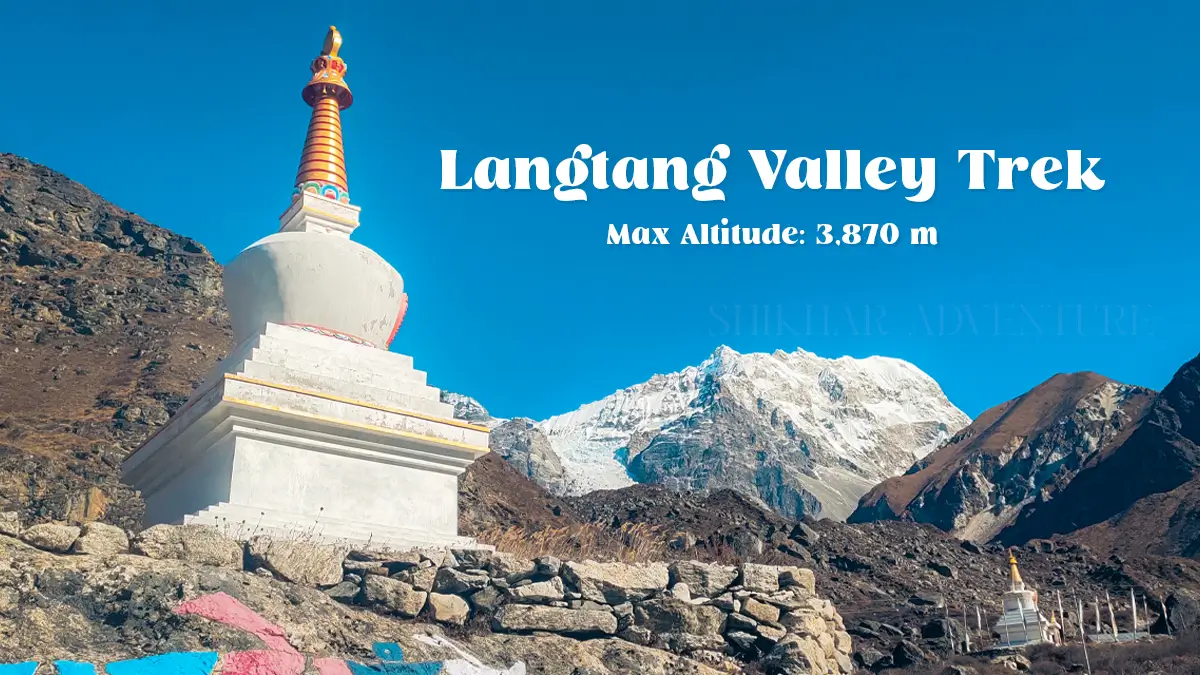
Quick Facts:
- Duration: 7–8 days
- Maximum Altitude: 3,870m (12,697ft)
- Difficulty: Easy–Moderate
- Daily Walking: 5–6 hours
- Best Months: October–November, March–May
Why It's Perfect for Beginners:
Langtang is great for beginners as it gives you a deep cultural experience without being very high up. Also, the valley has beautiful views of the mountains all the way through. Additionally, it's less crowded than Annapurna region treks.
What to Actually Expect:
The trek follows the Langtang River through bamboo forests. Subsequently, you'll pass traditional Tamang villages unchanged for centuries. Meanwhile, prayer flags and monasteries add cultural richness.
Kyanjin Gompa serves as the trek's highlight. Specifically, this monastery village sits below towering peaks. Moreover, optional day hikes offer additional acclimatization.
The 2015 earthquake devastated this region. However, villages that have been rebuilt now warmly welcome trekkers. In fact, your visit directly helps the area get better.
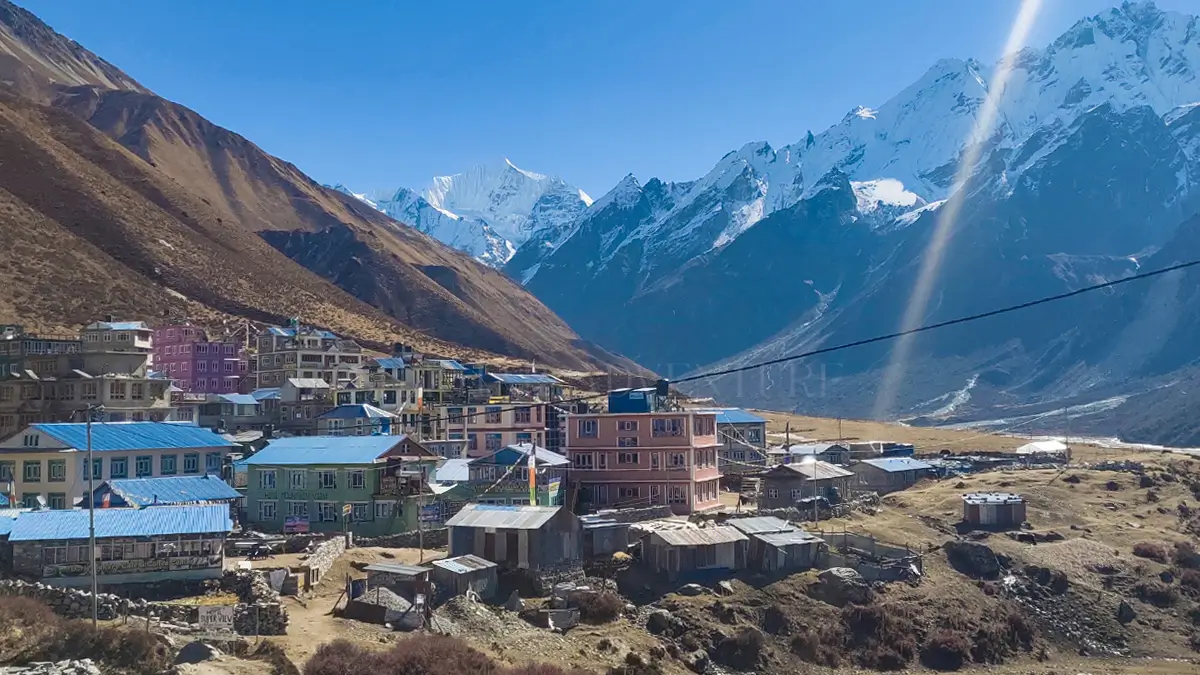
This is what they should pick:
Ideal for people who want more than just mountain views. Similarly, great for people who want to get more involved. Also great for shooters who want to capture real moments.
Check out our Langtang Valley Trek package information →
Mardi Himal Trek: The Hidden Gem
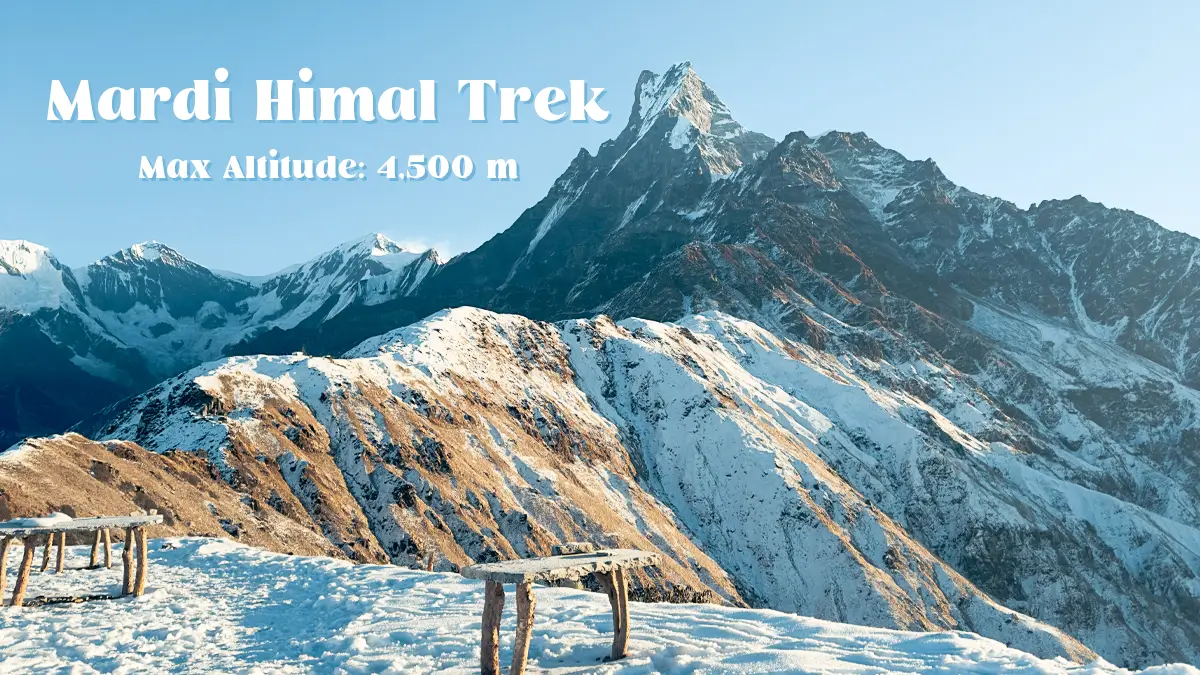
Quick Facts:
- Duration: 7–8 days
- Maximum Altitude: 3,870m (12,697ft)
- Difficulty: Easy–Moderate
- Daily Walking: 5–6 hours
- Best Months: October–November, March–May
Why It's Ideal for Beginners:
Compared to well-traveled routes, Mardi Himal is still largely unexplored. Consequently, you'll experience quieter trails and authentic interactions. Furthermore, the view-to-effort ratio is outstanding.
What to Actually Expect:
The trek winds through pristine rhododendron forests. Subsequently, trails narrow as you gain altitude. Meanwhile, Machapuchare (Fishtail Mountain) dominates the skyline.
High Camp at 3,580m provides the base. From there, you'll ascend to Mardi Himal Base Camp. Specifically, standing before Annapurna's south face is breathtaking.
The altitude pushes beginners slightly more than other treks. However it's very manageable with the right acclimatization. It is also accessible due to its shorter duration.
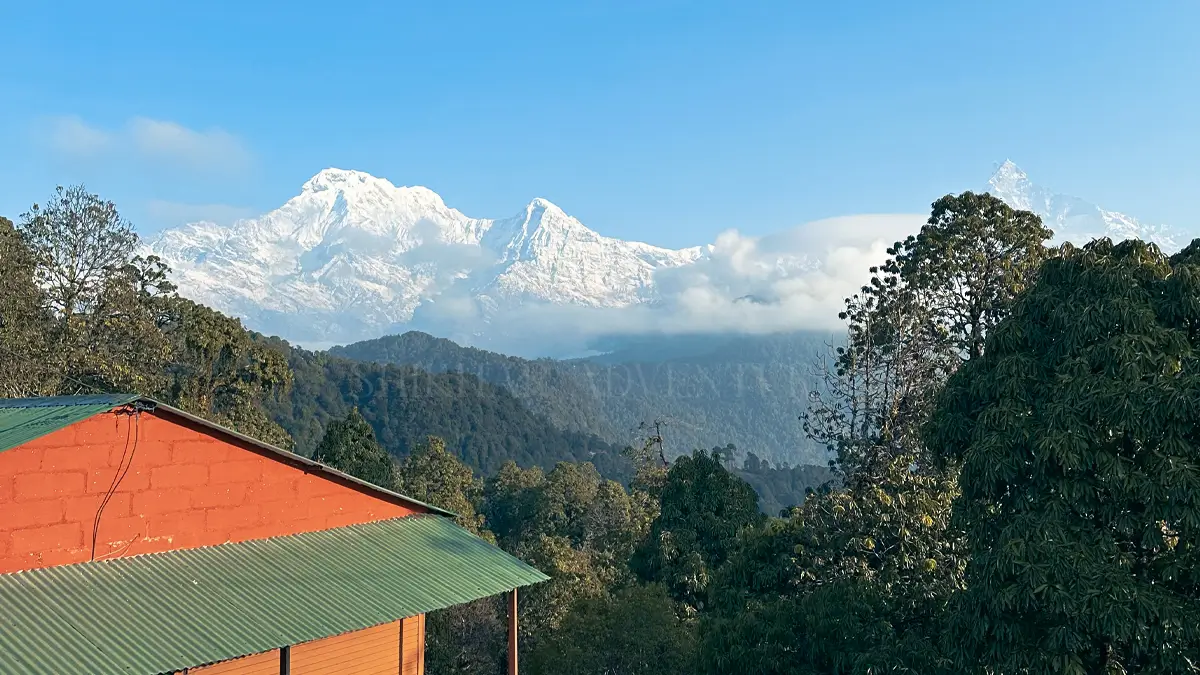
Who Must Select This:
Ideal for daring novices seeking something unique. Likewise, perfect for people who want to avoid crowded trails. Additionally, excellent for time-pressed trekkers.
Check our Mardi Himal Trek itinerary and availability →
Annapurna Base Camp Trek: The Achiever's Goal
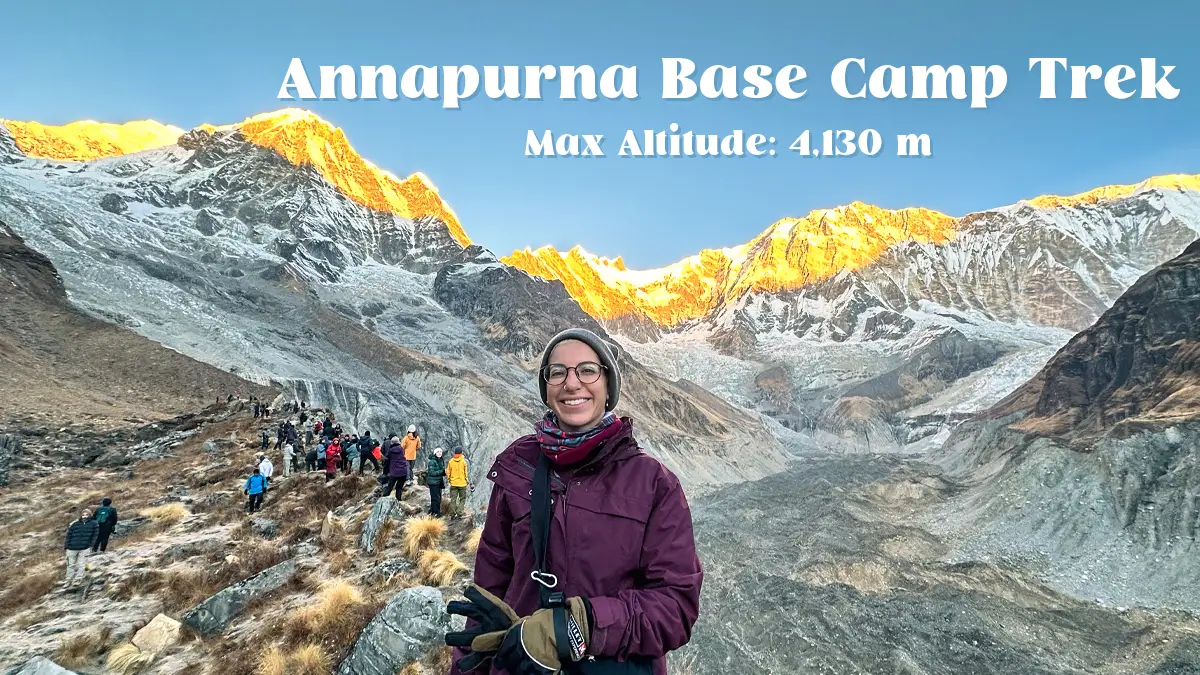
Quick Facts:
- Duration: 7–12 days
- Maximum Altitude: 4,130m (13,549ft)
- Difficulty: Moderate
- Daily Walking: 5–7 hours
- Best Months: October–November, March–April
Why It's Perfect for Beginners:
ABC represents a significant achievement without technical climbing. Furthermore, standing in the Annapurna amphitheater feels extraordinary. Additionally, gradual ascent allows proper acclimatization.
What to Actually Expect:
The trail ascends through diverse climate zones. First, subtropical forests give way to alpine meadows. Subsequently, you enter the dramatic Modi Khola gorge.
Reaching ABC at dawn is genuinely magical. Specifically, you're surrounded 360 degrees by towering peaks. Moreover, the sense of accomplishment is profound.
The gorge section can feel claustrophobic for some. However, it's also thrillingly dramatic. Additionally, the final push to ABC tests determination.
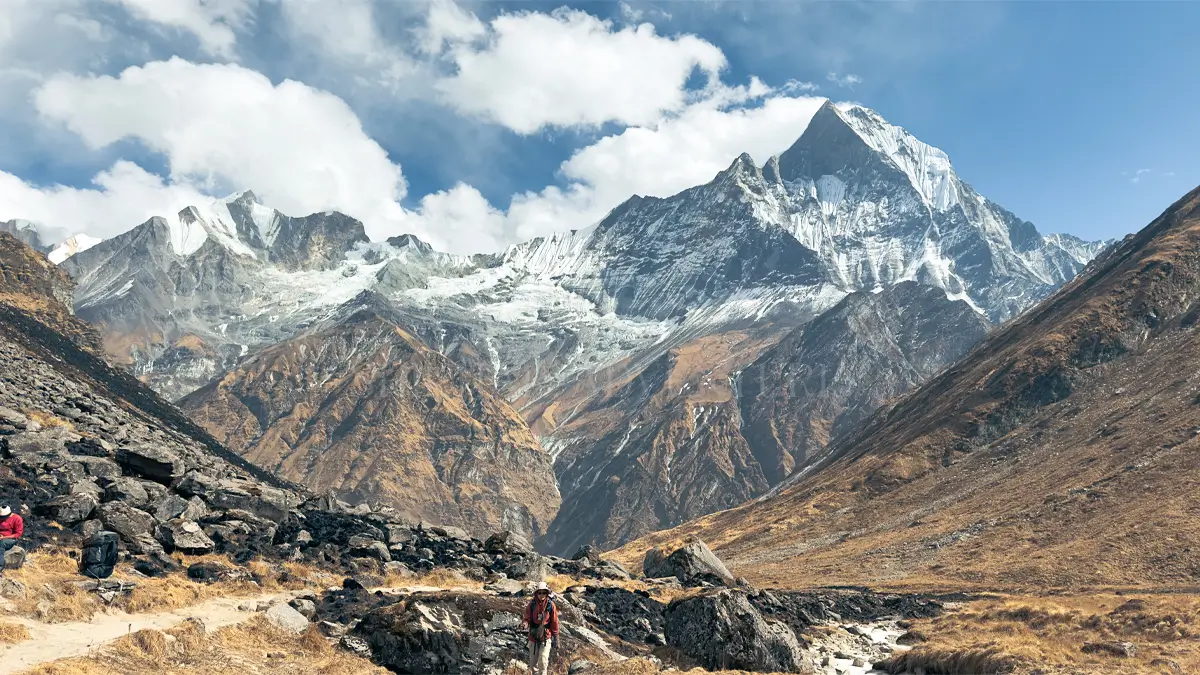
Who Must Pick This:
Perfect for ambitious beginners seeking a challenge. Likewise, ideal for people looking for famous locations. Excellent for boosting confidence for upcoming hikes as well.
The Toughest Day: Deurali to ABC—excitation and altitude come together.
View our comprehensive Annapurna Base Camp Trek program →
Everest View Trek: Everest Without Extreme Commitment
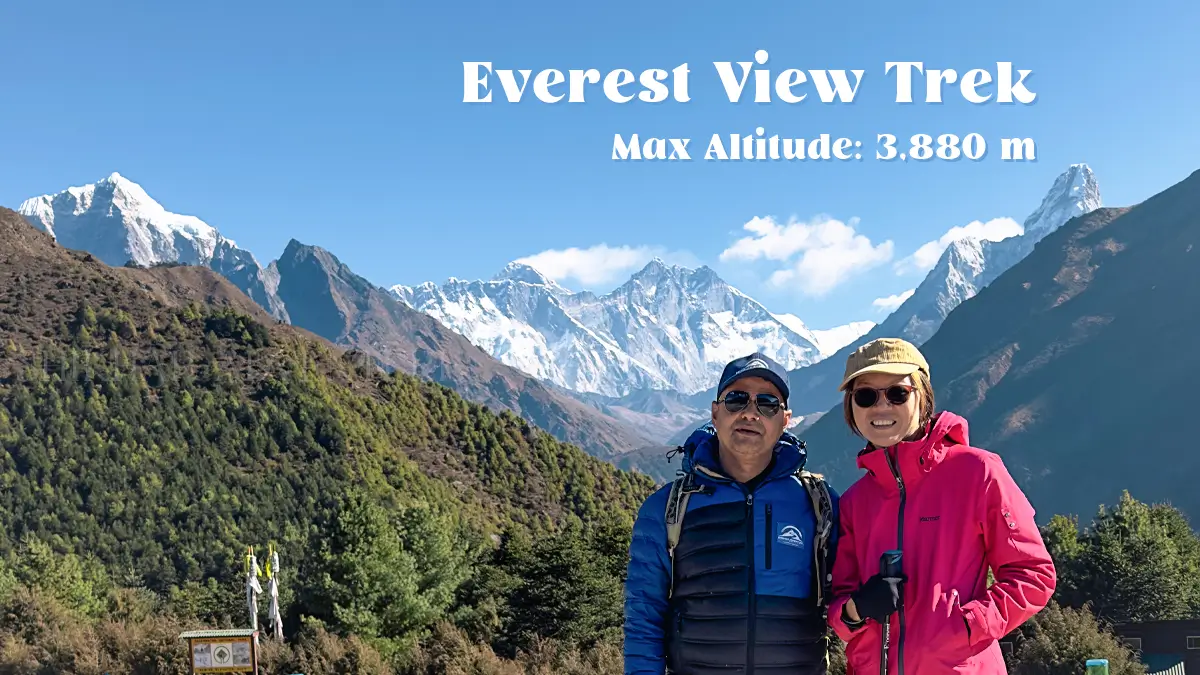
Quick Facts:
- Duration: 5–7 days
- Maximum Altitude: 3,880m (12,730ft)
- Difficulty: Easy–Moderate
- Daily Walking: 4–6 hours
- Best Months: October–November, March–May
Why It's Perfect for Beginners:
Experience Everest region without committing to EBC's duration. You'll also fully immerse yourself in Sherpa culture. Seeing Everest from Namche also checks things off of bucket lists.
What You Should Really Expect:
The dramatic flight to Lukla starts the adventure. Subsequently, you'll trek through Sherpa heartland. Meanwhile, prayer wheels, mani walls, and monasteries line trails.
Namche Bazaar serves as the Sherpa capital. Specifically, this amphitheater town offers stunning mountain views. Moreover, Saturday's market provides cultural immersion.
The Lukla flight intimidates some beginners. However, pilots navigate these conditions daily. Additionally, it's safer than statistics suggest.
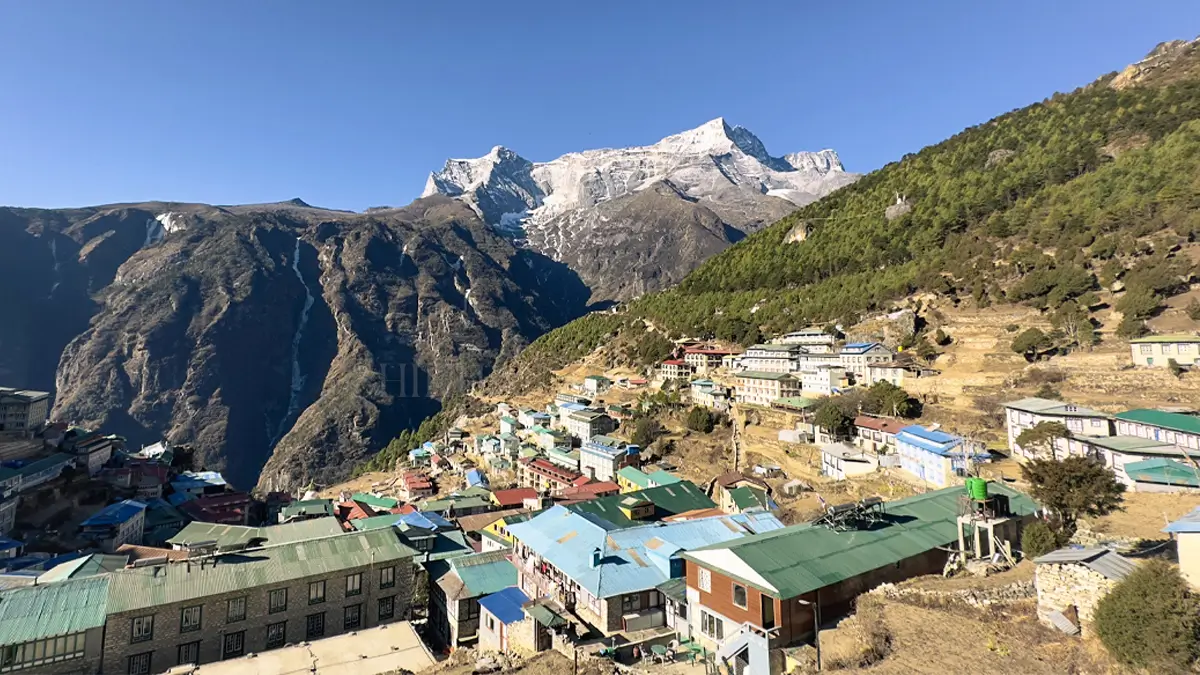
Who Should Choose This:
Perfect for Everest enthusiasts with limited time. Similarly, ideal for cultural experience seekers. Also, it's a great way to test the Everest region before going to EBC.
Discover our Everest View Trek experience →
Trek Difficulty Comparison Table
| Trek Name | Duration | Max Altitude | Difficulty | Best For |
|---|---|---|---|---|
| Poon Hill | 4-5 days | 3,210m | Easy | First-timers, limited time |
| Langtang Valley | 7-8 days | 3,870m | Easy-Moderate | Culture seekers |
| Mardi Himal | 5-7 days | 4,500m | Moderate | Off-the-beaten-path |
| Annapurna Base Camp | 7-12 days | 4,130m | Moderate | Ambitious beginners |
| Everest View | 5-7 days | 3,880m | Easy-Moderate | Everest enthusiasts |
How Fit Do You Really Need to Be?
The Honest Fitness Assessment
"Moderately fit" gets thrown around constantly. However, what does that actually mean? Specifically, let's define it with measurable standards.
You need cardiovascular endurance, not peak athleticism. Moreover, leg strength matters more than upper body. Further, mental strength is often more important than physical strength.
Self-Assessment Checklist
Can you currently do these activities comfortably?
- Walk 2 hours at moderate pace without stopping
- Climb 4-5 flights of stairs without gasping
- Carry a 5kg daypack for 30 minutes
- Exercise 3-4 times weekly currently
- Handle minor discomfort without complaining
If you checked 3 or more, you're ready to begin training. Conversely, if you checked fewer, start building baseline now.
Age Considerations: Real Talk
Age matters less than you think. Specifically, I've guided successful 65-year-olds and struggling 25-year-olds. However older trekkers usually have better pacing skills.
Youth provides recovery speed advantages. Conversely, experience brings mental preparation strengths. Therefore, focus on your individual preparation, not age.
The 8-Week Training Plan for Trekking
Weeks 1 and 2: Getting Started
Goal: Build up your baseline endurance and make exercise a regular part of your life.
Four times a week workouts:
- Walks of 30 to 45 minutes at a comfortable pace
- Flat ground or small hills
- Keep your breathing steady as much as possible
- No need to push hard yet
Also, start breaking in your trek boots by going for walks.
Weeks 3–4: Adding Height
Goal: Get your body used to the demands of climbing.
4–5 times a week, hike for 45–60 minutes with an elevation gain.
- Find hills, stairs in a stadium, or hiking trails
- Add 200 to 300 meters of elevation gain to each session
- Keep up a conversational pace the whole time
Also, start carrying a backpack with 5 kg of weight.
Weeks 5–6: Lengthening the Time
Goal: Get used to hiking for 5–6 hours a day.
Workouts (4–5 times a week):
- 60–90 minutes of hiking with elevation
- Try to gain 400 to 500 meters in height
- Add 2–3 longer weekend sessions (2–3 hours)
- Make the pack heavier by 8 kg
Also, practice hiking on consecutive days to get used to multi-day hiking.
Weeks 7 and 8: Best Performance
Goal: Test readiness by simulating real trek conditions.
Five times a week, do workouts:
- One long day: 3–4 hours with an elevation of 600m or more
- Two medium days of 90 to 120 minutes with elevation
- Two shorter days of maintenance: 60 minutes
- The weight of a full pack is 10 to 12 kg
Finally, plan your longest training hike for 10 to 14 days before you leave.
Important Tips for Training
Do this:
- Train regularly instead of hard
- Practice on different kinds of ground
- Try starting early in the morning every now and then
- Train in boots that you will wear
- Include day hikes on back-to-back days
Don't do this:
- Training too hard too quickly (risk of injury)
- Not taking rest days (recovery is important)
- Training only on flat surfaces
- Waiting until a month before leaving
- Not paying attention to small injuries
Alternatives to the Gym
Can't get to the hills or trails? So, try these other options:
Cardio Choices:
- Stair climber machine: 45 to 60 minutes
- Walking on an incline treadmill: at least 15% grade
- 60 minutes on an elliptical with resistance
- Classes for step aerobics are very hard
Power Training (twice a week):
- Squats and lunges to build leg strength
- Step-ups with weights (like climbing stairs)
- Calf raises (stability going down)
- Core exercises (carrying a pack)
What Will Your First Trek Actually Cost?
Complete Budget Breakdown for 2026
Understanding real costs eliminates unpleasant surprises. Moreover, transparent pricing builds confidence. Therefore, here's the comprehensive breakdown:
Budget Trek Option:
| Expense Category | Cost (USD) | Notes |
|---|---|---|
| Trek Package (guided) | $700-950 | Varies by trek length |
| International Flights | $800-1,200 | Depends on origin city |
| Kathmandu Hotels (3 nights) | $60-90 | $20-30 per night |
| Meals on Trek | Included | Part of package |
| Permits & TIMS | Included | Part of package |
| Gear Rental | $80-120 | If not buying new |
| Guide/Porter Tips | $100-150 | Industry standard |
| Travel Insurance | $80-120 | Comprehensive coverage |
| Extras & Contingency | $100-150 | Snacks, charges, etc. |
| TOTAL | $1,920-2,780 | Complete trip cost |
Mid-Range Trek Option:
| Expense Category | Cost (USD) | Notes |
|---|---|---|
| Trek Package (guided) | $1,000-1,500 | Better lodges, services |
| International Flights | $900-1,300 | Flexible tickets |
| Kathmandu Hotels (3 nights) | $120-180 | $40-60 per night |
| Meals on Trek | Included | Part of package |
| Permits & TIMS | Included | Part of package |
| New Gear Purchase | $150-400 | Essential items only |
| Guide/Porter Tips | $150-200 | Higher standard |
| Travel Insurance | $100-150 | Premium coverage |
| Extras & Contingency | $150-250 | Comfort items |
| TOTAL | $2,570-3,980 | Comfortable experience |
Luxury Trek Option:
| Expense Category | Cost (USD) | Notes |
|---|---|---|
| Trek Package (luxury) | $2,000-3,500 | Premium lodges, services |
| International Flights | $1,200-1,800 | Business class options |
| Kathmandu Hotels (3 nights) | $250-400 | 4-5 star hotels |
| Meals on Trek | Included | Gourmet options |
| Permits & TIMS | Included | VIP processing |
| Premium Gear | $400-800 | High-end equipment |
| Guide/Porter Tips | $250-350 | Premium service |
| Travel Insurance | $150-200 | Comprehensive coverage |
| Extras & Contingency | $250-400 | Full comfort items |
| TOTAL | $4,500-7,450 | Luxury experience |
Hidden Costs Nobody Mentions
Beyond the obvious expenses, budget for these:
On-Trail Extras:
- Hot showers: $3-5 each (you'll want them)
- Device charging: $2-4 per device
- WiFi access: $2-5 daily (slow but available)
- Extra snacks: $5-10 daily (chocolate, cookies)
- Bottled water: $1-3 per liter (increases with altitude)
Total Hidden Costs: Add $150-250 to your budget.
Guided vs Independent: 2025 Rules Changed Everything
In November 2025, the government of Nepal put new rules in place. Most trekking areas now require registered guides, to be exact. Consequently, true independent trekking is no longer possible in some regions.
Why 95% of Beginners Choose Guided:
Guides provide more than just navigation. Moreover, they offer:
- Cultural interpretation and language translation
- Optimal pacing for altitude acclimatization
- Weather and trail condition updates
- Emergency response and first aid
- Teahouse booking and meal ordering
- Porter coordination if needed
Cost Difference:
Independent trekking saves perhaps $200-300. But they miss out on the real experiences and stories that guides and porters can tell. So, the value guides are worth much more than what they cost.
A List of Things to Pack for Your First Time
The Things You Can't Change
Shoes (Most Important):
- Hiking boots that have been worn in (waterproof and with ankle support)
- Camp shoes are light slip-on shoes that you can wear at night
- 4–5 pairs of hiking socks that wick away moisture
- Sock liners to keep blisters from forming
Layering System for Clothes:
Base Layer:
- Two long-sleeve shirts that wick away moisture
- One or two pairs of thermal leggings or long underwear
- Underwear that dries quickly (4-5)
- 3–4 women's sports bras
Mid Layer:
- A fleece jacket or pullover (1)
- An insulated jacket (down or synthetic)
- Trekking pants (two pairs, one that can be changed)
- Hat for the sun and hat for the cold
Outer Layer:
- A rain jacket that keeps water out (but lets air in)
- Lightweight, packable rain pants
- Jacket that won't let the wind through (if not using a rain jacket)
Accessories:
- Warm gloves and liner gloves
- Sunglasses (must protect against UV rays)
- Buff or neck gaiter (can be used in many ways)
- Headlamp with extra batteries
Things You Need:
- Sleeping bag (comfortable at -10°C)
- Trekking poles (help your knees on the way down)
- Daypack 30–40L (if the porter carries the main bag)
- Main duffel bag (60–80L) for the porter
- Water bottles or a hydration bladder with a capacity of 2 to 3 liters
- Water purification (tablets or filter)
Health and Safety:
- A full first aid kit
- Diamox is a drug for altitude sickness
- Medications that are prescribed to you
- Lip balm and sunscreen with an SPF of 50 or higher
- Toilet paper and hand sanitizer
- Basic toiletries (just the basics)
Electronics:
- Cables for phones and charging
- Power bank with at least 20,000mAh
- Camera (not required; phone works)
- Type C, D, and M plug adapter for Nepal
Papers:
- Passport (valid for six months)
- Printed information about travel insurance
- Information about emergency contacts
- Copies of trekking permits
- Get cash in NPR (ATMs are few and far between on the trail)
What NOT to Bring
Beginners often overpack dramatically. Therefore, leave these behind:
- Hair dryer (no electricity for this)
- Makeup beyond basics (you won't care)
- Multiple outfit changes (repeat clothing)
- Heavy books (download ebooks)
- Valuable jewelry (unnecessary risk)
- Cotton clothing (stays wet, provides no warmth)
Rent vs Buy in Kathmandu
Kathmandu's Thamel offers extensive gear rental. Moreover, quality has improved significantly. However, know what's worth renting.
Good Rental Options:
- Sleeping bags: $1-2 daily (clean, quality)
- Down jackets: $1-2 daily (puffy style)
- Trekking poles: $0.50-1 daily
- Duffel bags: $0.50-1 daily
Must Bring From Home:
- Hiking boots (fit too personal)
- Base layers (hygiene matters)
- Socks and underwear (obvious reasons)
- Personal medications
- Quality rain jacket (rental quality varies)
Packing Weight Guidelines
With Porter:
- Your daypack: 5-8kg maximum
- Porter duffel: 12-15kg maximum
- Total combined: 20kg limit strictly
Carrying Everything:
- Total pack weight: 12-15kg absolute maximum
- Aim for 10-12kg for comfort
Remember: less is genuinely more
Facing Your Fears: Truthful Answers
Fear #1: Getting sick at high altitudes
Q: What if I get sick from being at a high altitude?
About 25% of trekkers get mild altitude sickness. But serious cases are still rare on beginner treks. Also, acclimatization done right stops most problems.
Some mild symptoms are:
- Most common: headache
- A little bit of nausea
- Tiredness that goes beyond normal tiredness
- Can't sleep well
Ways to avoid:
- Gradually go up (no more than 300–500m a day above 3,000m)
- Drink 3 to 4 liters of water every day
- Don't drink alcohol for the first few days
- Think about taking Diamox (talk to your doctor first)
- Pay attention to everything your body says
When to go down right away:
- Severe headache that medicine won't help
- Throwing up all the time
- Confusion or a lack of coordination
- Breathlessness while at rest
Severe AMS is rare on beginner hikes below 4,000 meters. Still, your guide keeps an eye on you all the time. There are also plans for evacuating in case of an emergency.
Fear #2: The Bathroom Situation
Q: How bad are the toilets really?
Let's be honest about this: it changes a lot. But it's not usually as bad as people think. Also, you adapt to things surprisingly quickly.
What you can expect:
- Areas for tourists: Toilets in the Western style (mostly clean)
- Remote teahouses: Squat toilets (easier to use but still work)
- Shared facilities: Most lodges have them
- Basic cleanliness: Generally well-kept
Useful advice:
- Bring your own toilet paper (very important)
- Bring a lot of hand sanitizer with you
- Headlamp for visits at night (necessary)
- Baby wipes to clean up
- Right away, lower your expectations
On the third day, you won't care at all. A lot of trekkers actually find it strangely freeing. Also, the amazing views make up for the lack of basic bathroom facilities.
Fear #3: Moving too slowly
Q: What if I'm the slowest person?
In Swahili, "pole pole" means "slowly slowly." But Nepali guides did this perfectly. Himalayan trekking, in particular, celebrates slowness on purpose.
Your guide sets a slow pace on purpose. Also, going faster isn't always better at high altitudes. In fact, moving quickly makes the risk of altitude sickness much higher.
Check your reality:
- Groups naturally spread out on the trail
- Every 45 to 60 minutes, there is a break
- There is no judgment for going slower
- A lot of "fit" people have a harder time than beginners
I've helped over 850 people, and none of them have embarrassed themselves. Also, mental strength is more important than speed. So, don't worry about how fast you're going; just keep making progress.
Fear #4: Worries about safety
Q: Is it safe for women and people traveling alone to go to Nepal?
Statistically, Nepal is one of the safest places to visit in Asia. Also, the trekking community adds an extra layer of safety. Also, violent crimes against tourists are very rare.
For women who hike in particular:
- On trails, sexual harassment isn't common
- There are more and more women who hike alone
- Families in teahouses make a safe place to live
- Guides learn how to keep women safe
- Wearing modest clothes shows respect for other cultures
General safety information:
- Most trail accidents hurt people's ankles
- It is very rare for people to steal on trails
- Guides have satellite phones in case of emergencies
- Helicopter evacuation is an option if needed
Forty percent of our clients are women who travel alone. Also, a lot of people come back for more hikes. So, it's understandable that people are worried, but most of the time, they aren't true.
Fear #5: Getting hurt
Q: What will happen if I get hurt?
Sometimes people get small injuries, like blisters, knee pain, or an upset stomach. But serious injuries are still rare. There are also full support systems in place.
Common problems and their solutions:
- Blisters: You can avoid them by wearing the right socks and boots
- Knee pain: Trekking poles cut down on impact by 30%
- Stomachache: Usually mild and goes away quickly
- Sprains: Rest, raise the injured area, and get help from a porter
Emergency procedures:
- Guides have full first aid kits with them
- Satellite communication gets to rescue services
- Helicopter evacuation is possible, but you need insurance
- Teahouses are closer together on beginner routes
Helicopter evacuation must be covered by your travel insurance. Policies should cover at least $50,000 in damages. Also, check the policy for altitude limits.
Fear #6: Not Having Fun
Q: What if I realize halfway through that I hate trekking?
This happens very rarely, maybe to 1 out of every 50 trekkers. It's usually for non-physical reasons as well. There are, however, exit strategies.
There are several ways to get off of every beginner trek:
- Access to the road in 4 to 8 hours at the most
- Your guide sets up transportation right away
- No punishment or judgment for going back
- Partial refunds may be possible depending on when they are requested
A fair evaluation based on experience:
- The first two days are the hardest mentally (getting used to it)
- From day 3 on, things usually start to happen
- Most people who "quit" say they had family problems, not that they didn't like the trek
- Physical challenges don't make you feel like you're losing; they make you feel like you're winning
Most beginners are surprised by how much they change. In particular, doubts turn into confidence. So, at first, trust the process.
From Decision to Departure: A Timeline of Events
6 to 8 months before the trek
The research and booking stage:
- Look into all the different trek options very carefully
- Choose a departure date (October to November or March to April are best)
- Book with a well-known trekking company like [Company]
- Get tickets for international flights
Why you should book ahead:
- Better prices on international flights (save $200 to $400)
- Peak season departures fill up fast
- More time to get your mind ready
- The training timeline fits perfectly
Three to four months before the trek
Getting ready gets more intense:
- Start an 8-week training program (or keep building your base)
- Start getting gear (gives you time to break it in)
- Get full travel insurance
- Get a Nepal visa (e-visa or on-arrival)
Strategy for getting gear:
- Get boots now (they need 6 to 8 weeks to break in)
- Try out your sleeping bag on cold nights
- Practice putting things in and taking them out of bags
- Choose whether to rent or buy the rest of the things
1 to 2 months before the trek
Last stage of preparation:
- Weeks of peak training intensity
- Finish the packing list completely
- Set up the necessary vaccinations (talk to a doctor)
- Get your body ready by sleeping and drinking water
Vaccines to think about:
- Hepatitis A and B (recommended)
- Typhoid (recommended for Nepal)
- Routine shots (like tetanus)
- Rabies (optional, talk to a travel doctor)
Two Weeks Before the Trek
Last-minute things to do:
- Try out all of your gear on the longest hike you do for training
- Make sure to break in your boots well
- Download maps and guides that work without the internet
- Change money or set up access to an ATM
- Put bags together and weigh them
Getting ready for the trek:
- Drink a lot more water
- Get enough sleep (at least 8 hours)
- Eat healthy foods and stay away from alcohol
- Think about acclimating to Diamox (talk to your doctor)
Week of Arrival in Kathmandu
Orientation and last-minute preparations:
- Go to the guide's pre-trek briefing
- Fill out all the paperwork and take pictures for the permit
- Rent any gear you still need in Thamel
- Explore Kathmandu (important day to get used to the weather)
Don't miss the day off:
- Your body needs to get used to the higher altitude
- Time to get your mind ready is important
- Visiting cultural sites gives you context
- Last checks and adjustments to the gear
Quick Answers to Your Questions: FAQS
Can I trek Nepal with zero hiking experience?
Yes, absolutely—on beginner-rated trails like Poon Hill. Moreover, 30% of our clients had never done multi-day hiking. But it is still important to train every day for eight weeks. Also, picking the right treks and hiring experienced guides will help you succeed.
Begin with our Poon Hill trek for beginners →
What is the best first hike in Nepal?
Poon Hill is a great place to quickly try out Himalayan trekking. Langtang Valley, on the other hand, lets you get more involved if you have the time. Both stay below 4,000 meters and have great infrastructure. So, make your choice based on how many vacation days you have.
Do I need a guide or can I trek independently?
2025 regulations now mandate guides for most trekking areas. Beyond legality, 95% of first-timers benefit enormously from guide expertise. Specifically, guides provide pacing wisdom, cultural interpretation, and safety management. Therefore, guided trekking makes sense for beginners.
Learn about our experienced guide team →
When is the absolute best time for beginners?
Late September through November offers ideal conditions consistently. In particular, the weather is stable, the mountains are clear, and the temperatures are pleasant. March through April ranks second with rhododendron blooms. However, afternoon clouds obscure views occasionally. Avoid monsoon season completely (June-August).
How much should I budget total?
Expect $700-$1,200 for budget-conscious trekking all-inclusive. This covers guided services, permits, accommodation, and most meals. However, it excludes international flights ($800-1,400) and personal gear ($100-400 if buying new). Luxury comfort trekking runs $2,000-$3,500 total.
What if I need to turn back midway?
All beginner treks feature multiple exit points with road access. Specifically, your guide coordinates transportation within 4-8 hours maximum. We've experienced only 2% early returns—usually family emergencies, not trek difficulty. Therefore, exit strategies exist but rarely get used.
Are teahouse lodges comfortable enough?
Teahouse lodges provide simple but adequate twin rooms. Specifically, expect thin mattresses, pillows, and blankets provided. Bring a sleeping bag liner for warmth and hygiene. Facilities are basic—no heating, shared bathrooms—but clean and remarkably social. It's comfortable enough, not luxury.
Can I charge devices on the trail?
Yes, most teahouses offer charging for $2-4 per device. However, bring a large power bank (20,000mAh) as backup. Additionally, charging takes longer at higher altitudes. Solar chargers sound appealing but work poorly under forest cover. Therefore, rely on power banks primarily.
What fitness level do I actually need?
If you can climb three flights of stairs without stopping, you have baseline fitness. Additionally, two-hour comfortable walks indicate adequate endurance. From there, our 8-week training plan builds systematically. Therefore, moderate fitness plus consistent training equals trek success.
Is altitude sickness a serious concern?
Severe altitude sickness is still rare on beginner treks below 4,000 meters. But about 25% of trekkers have mild symptoms. Most problems can be avoided by getting used to the altitude, going up slowly, and drinking enough water. Guides also keep an eye on things all the time and know when to go down. So, it's possible to handle with care.
Why Trek With Us: Our Promise to Beginners
Local Knowledge, Global Standards
We don't just run a trekking business; we live in the mountains. Our guides, in particular, grew up in these valleys. They have also successfully led more than 2,000 people on their first trek. So, we know a lot about how beginners feel nervous.
The standards for our guides are:
- At least 8 years of experience as a guide
- Certified as a Wilderness First Responder
- Fluent in English
- Expertise in cultural interpretation
- Be patient, especially with beginners
Small groups and individual attention
We only let 12 people in a group on purpose. As a result, guides pay attention to each person the whole time. Also, smaller groups can keep up with the pace of the lesson. Also, you'll make real friends, not just people to hike with.
No surprises, clear prices
Our quotes make it clear what we promise. In particular, there are no hidden fees that show up out of nowhere. We also make it clear what is included and what is extra. So, you need to make sure your budget is right from the start.
What Always Comes With
- Guide who speaks English well
- All fees and permits for trekking
- Teahouse lodging all the time
- Three meals a day on the trail and transfers to and from the airport in Kathmandu
- Briefing and orientation before the trek
Always Put Safety First
We will always put your safety first. Guides, in particular, carry full first aid kits. Also, satellite phones let you talk to people in an emergency. We also have partnerships for helicopter evacuation insurance.
Our History of Safety:
- In 8 years, there have been no serious incidents
- 100% of beginners who start the trek finish it (not counting those who leave on their own)
- Protocols for immediate response set up
- All staff should get regular safety training
Responsible Trekking Promise
We pay porters fairly, and their pay is higher than the industry average. We also only work with family-run teahouses. We also follow strict "leave no trace" rules. So, your trek helps local communities in a way that lasts.
Your next steps: Make your dreams come true
Stop looking things up and start making plans.
You have read more than 3,000 words about trekking in Nepal for beginners. So, you now know more than 90% of people. Also, knowledge is just information if you don't do anything with it. So, now is the time to make a decision.
The change is waiting for you.
It's not just about getting to viewpoints on your first trek in Nepal. Instead, it's about finding out what you can do that you didn't think you could. Also, it's about really getting to know cultures that are very different from your own. Also, it's about coming back home with a real change.
The mountains don't care how fit or experienced you are. They also welcome everyone who comes up to them with respect. So, your doubts shouldn't stop you.
Do Something Today
You can now book your 2026 beginner trek departures. Dates in October and November fill up the fastest. Also, small group sizes mean that there aren't many spots available. So, booking early guarantees that you'll get the dates you want.
Are you ready to turn doubt into success?
Our experts on treks know exactly what first-timers need. In particular, they'll help you pick the best trek. They'll also patiently answer any other questions you have. They'll also make a personalized timeline for your preparation.
Get in touch with a Trek expert — 15-Minute Consultation for Free
Don't worry about it. Just honest advice from people who love the mountains.
Your Guide's Final Thoughts
For more than 15 years, I've seen hundreds of people go from being nervous beginners to confident trekkers. Moreover, the pattern repeats beautifully every time. Specifically, fear transforms into excitement, doubt becomes determination, and strangers become friends.
Your biggest obstacle isn't fitness or experience. Instead, it's taking that first step forward. However, you've already started by reading this guide. Therefore, you're closer than you realize.
The Himalayas will still stand tomorrow and next year. However, life rarely hands us perfect moments. Moreover, responsibilities always exist as excuses. Therefore, at some point, you must simply decide.
Nepal's mountains have taught me that limits exist mostly in minds, not bodies. Furthermore, beginners often surprise themselves most dramatically. Additionally, the journey matters far more than the destination.
Your summit awaits. The only question remaining: when will you start climbing?
Ready to Transform Uncertainty Into Achievement?
Primary Action: Book Your Free Consultation
Our trek specialists have guided hundreds of anxious beginners to summit success. Specifically, they'll help you choose the perfect trek for your goals. Moreover, they'll answer every remaining question with patience. They will also make a personalized timeline for your preparation.
This call lasts 15 minutes and includes:
- Trek suggestion based on your schedule
- Honest fitness evaluation and training advice
- A full breakdown of costs with no pressure
- Departure date options for 2026
- Full answers to all of your questions
No pressure. Free 15-minute consultation.
One Final Thought From the Mountains
The Himalayas teach us that every summit begins with a single step. Moreover, that step feels hardest because it requires leaving comfort behind. However, it's also the most important step you'll take.
Fourteen years ago, I watched a 62-year-old grandmother complete her first trek. Specifically, she'd spent years saying "someday." Finally, she chose "today" instead.
At the summit, she cried—not from exhaustion, but from regret. "Why did I wait so long?" she asked. "I was capable all along."
Don't let fear steal years from your dreams. Moreover, don't let doubt prevent experiences that define lives. Instead, choose courage over comfort today.
Your summit is waiting. The trail begins with your decision.
See you in the mountains,
Lead Trek Guide
15+ Years Guiding | 200+ First-Timers Led to Success



